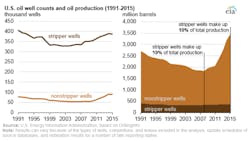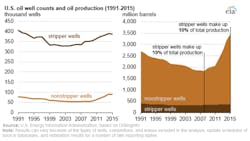BHI: Land, oil rigs lift overall US rig count by 10 units
Lifted entirely by onshore oil-directed units, the US drilling rig count jumped by 10 during the week ended July 1 for the second time in 3 weeks, tallying 431 rigs working, according to data from Baker Hughes Inc.
The count has now risen in 4 of the past 5 weeks, gaining 27 units over that time (OGJ Online, June 24, 2016). Since the overall drilling dive commenced following the week ended Dec. 5, 2014, the count has fallen 1,489 units.
Amid the recent increase in drilling activity, the US Energy Information Administration this week noted that some 380,000 stripper oil wells were operating in the US at yearend 2015 compared with just 90,000 nonstripper oil wells.
Stripper wells, which produce no more than 15 boe/d over a 12-month period, accounted for 10% of overall US crude oil production in 2015. Their share of output, however, was down nearly half from their 2008 level because of “the large increase of production volume from very prolific wells drilled in shale and tight oil formations with enhanced completion techniques,” EIA explained.
The agency also reported that overall US crude production during the week ended June 24 fell 55,000 b/d to 8.622 million b/d, a year-over-year decline of 973,000 b/d.
Oil rigs’ upward momentum
Up 11, the US oil-directed rig count now totals 341, a 25-unit increase since May 27. Compared with its peak in BHI data on Oct. 10, 2014, the total is now down 1,268 units.
Following a 4-unit jump last week, gas-directed rigs in the US edged down a unit to 89.
Land-based rigs also gained 11 units, now totaling 408. Rigs engaged in horizontal drilling rose 7 units to 332, up 18 since May 27. They’re now down 1,040 units since a peak in BHI data on Nov. 21, 2014. Directional drilling rigs fell 5 units to 38.
Rigs drilling offshore US dropped 2 units to 19, their lowest count since Oct. 1, 2010, less than 6 months after the Deepwater Horizon incident. Since then, the offshore count peaked at 66 on Aug. 29, 2014, and Sept. 12, 2014. Rigs drilling in inland waters, meanwhile, gained a unit this week to 4.
Contributing to shrinking offshore activity is Stone Energy Corp., which this week agreed with Ensco PLC to cancel the contract for the Ensco 8503 dynamically positioned deepwater drilling rig that was operating in the deepwater Gulf of Mexico (OGJ Online, June 30, 2016).
Canada’s rig count during the week sat unchanged at 76, reflecting a 1-unit increase in gas-directed rigs to 40, offset by a 1-unit decrease in oil-directed rigs to 35. One rig considered unclassified remains operating.
Canada’s recent upward momentum started earlier than that of the US, rising 40 units since May 6, the end of the spring thaw and resulting road restrictions.
Texas, Oklahoma lead states
Among the major oil- and gas-producing states, Texas and Oklahoma led the way each with 4-unit increases to 198 and 58, respectively.
Texas has recorded a gain in 5 straight weeks, adding 25 units over that time. The Permian increased 4 units to 154, up 20 units since May 13. The Barnett rose a unit to 8, while the Eagle Ford dropped a unit to 33.
Oklahoma’s count recouped last week’s losses in part because of a 2-unit rise in the Cana Woodford to 26.
Colorado gained 2 units to 19, reflecting a 2-unit rise in the DJ-Niobrara to 14. Louisiana edged up a unit to 42.
New Mexico and Alaska were the only states to post a decline, dropping a unit each to respective totals of 19 and 8. The Haynesville was the only other major basin to record a loss, falling 2 units to 17.
Contact Matt Zborowski at [email protected].

